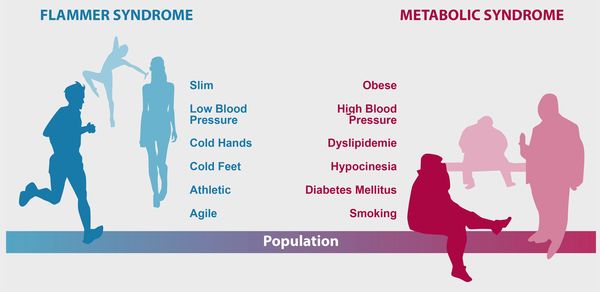The Flammer syndrome describes a combination of symptoms and signs which result from a predisposition to a generally increased sensitivity. The main focus is a modified, mostly increased response of the blood vessels to stimuli like cold or emotional stress and the resulting phenomenon like cold hands.
The increased sensitivity affects also other sensations like smell, pain, vibration or medication effects etc.
The following figure illustrates that (expressed in a simplified way) the Flammer Syndrome can be considered as the antipole of the metabolic Syndrome.

The core of the Flammer Syndrome is the so called primary vascular dysregulation (PVD). PVD has the following potential consequences:
- A weak reduction of blood flow, although sometimes unpleasant, has normally no long-term effects.
- Is dysregulation, however, very pronounced, e.g. with a marked local vasospasm, it can even induce (fortunately extremely seldom) an infarction of the affected tissue.
- More often a dysregulation, and particularly the disturbed autoregulation of ocular blood flow, leads to an unstable oxygen supply in the corresponding tissue. This in turn increases locally the production of free oxygen radicals. Fortunately nature is equipped with mechanism to eliminate these radicals. If, however, the production of free radicals exceeds the antioxidative capacity, the oxidative stress damages cell components and the resulting small tissue defects accumulate over time.
